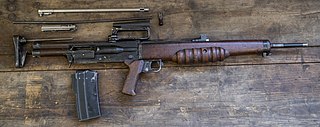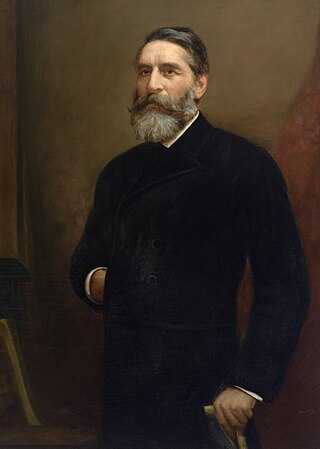Related Research Articles

The SA80 is a British family of 5.56×45mm NATO service weapons used by the British Army. The L85 Rifle variant has been the standard issue service rifle of the British Armed Forces since 1987, replacing the L1A1 Self-Loading Rifle. The prototypes were created in 1976, with production of the A1 variant starting in 1985 and ending in 1994. The A2 variant came to be as the result of a significant upgrade in the early 2000s by Heckler & Koch and remains in service as of 2024. The A3 variant was first issued in 2018 with several new improvements.

Bolt-action is a type of manual firearm action that is operated by directly manipulating the bolt via a bolt handle, most commonly placed on the right-hand side of the firearm. The majority of bolt-action firearms are rifles, but there are also some variants of shotguns and handguns that are bolt-action.

The Lee–Enfield is a bolt-action, magazine-fed repeating rifle that served as the main firearm of the military forces of the British Empire and Commonwealth during the first half of the 20th century, and was the standard service rifle of the British Armed Forces from its official adoption in 1895 until 1957.

The Ross rifle is a straight-pull bolt action rifle chambered in .303 British that was produced in Canada from 1903 until 1918.

The M1903 Springfield, officially the U.S. Rifle, Caliber .30, M1903, is an American five-round magazine-fed, bolt-action service repeating rifle, used primarily during the first half of the 20th century.

The Martini–Henry is a breech-loading single-shot rifle with a lever action that was used by the British Army. It first entered service in 1871, eventually replacing the Snider–Enfield, a muzzle-loader converted to the cartridge system. Martini–Henry variants were used throughout the British Empire for 47 years. It combined the dropping-block action first developed by Henry O. Peabody and improved by the Swiss designer Friedrich von Martini, combined with the polygonal rifling designed by Scotsman Alexander Henry.

The .303 British or 7.7×56mmR, is a .303-inch (7.7 mm) calibre rimmed tapered rifle cartridge. The .303 inch bore diameter is measured between rifling lands as is the common practice in Europe which follows the traditional black powder convention.

The Lee–Metford is a British bolt action rifle which combined James Paris Lee's rear-locking bolt system and detachable magazine with an innovative seven-groove rifled barrel designed by William Ellis Metford. It replaced the Martini–Henry as the standard service rifle of the British Empire in 1888, following nine years of development and trials, but remained in service for only a short time until replaced by the Lee–Enfield.

The EM-2, also known as Rifle, No.9, Mk.1 or Janson rifle, was a British assault rifle. It was briefly adopted by British forces in 1951, but the decision was overturned very shortly thereafter by Winston Churchill's incoming government in an effort to secure NATO standardisation of small arms and ammunition. It was an innovative weapon with the compact bullpup layout, built-in carrying handle and an optical sight.
A rifled musket, rifle musket, or rifle-musket is a type of firearm made in the mid-19th century. Originally the term referred only to muskets that had been produced as a smoothbore weapon and later had their barrels replaced with rifled barrels. The term later included rifles that directly replaced, and were of the same design overall as, a particular model of smoothbore musket.

The M1917 Enfield, the "American Enfield", formally named "United States Rifle, cal .30, Model of 1917" is an American modification and production of the .303-inch Pattern 1914 Enfield (P14) rifle, which was developed and manufactured during the period 1917–1918. Numerically, it was the main rifle used by the American Expeditionary Forces in Europe during World War I. The Danish Sirius Dog Sled Patrol in Greenland still use the M1917, which performs reliably in Arctic conditions, as their service weapon.
The Pattern 1913 Enfield (P'13) was an experimental rifle developed by the Royal Small Arms Factory for the British Army as a result of its combat experience in the Second Boer War from 1899 to 1902. The weapon was to serve as a replacement for the Short Magazine Lee–Enfield (SMLE). An advanced chamber design allowed for a high-velocity .276 Enfield rimless round, which was more powerful than the service-issued .303 British cartridge. Introduction of the P'13 was rendered impractical by the outbreak of the First World War.

The Rifle, .303 Pattern 1914 was a British service rifle of the First World War period, principally manufactured under contract by companies in the United States. It was a bolt-action weapon with an integral 5-round magazine. It served as a sniper rifle and as second-line and reserve issue, until declared obsolete in 1947. The Pattern 1914 Enfield was the successor to the Pattern 1913 Enfield experimental rifle and the predecessor of the U.S. Rifle M1917 Enfield.

The origins of the modern British military rifle are within its predecessor the Brown Bess musket. While a musket was largely inaccurate over 100 yards (91 m), due to a lack of rifling and a generous tolerance to allow for muzzle-loading, it was cheap to produce and could be loaded quickly. The use of volley or mass firing by troops meant that the rate of fire took precedence over accuracy.

The Enfield Pattern 1853 rifle-musket was a .577 calibre Minié-type muzzle-loading rifled musket, used by the British Empire from 1853 to 1867; after which many were replaced in service by the cartridge-loaded Snider–Enfield rifle.

James Paris Lee was a British Canadian inventor and arms designer. He is best known for having invented the Lee Model 1879 rifle, which is the first bolt-action detachable box magazine-fed rifle. These features would be incorporated into more successful repeating rifle designs later on, such as in the Lee–Metford and Lee–Enfield rifle series.

A drill purpose rifle is a rifle which has been altered so that it can no longer be fired. This is generally undertaken by either removing the firing pin or leading the barrel. These rifles are used solely for drill purposes, training and teaching, usually by cadet forces. These rifles can be marched with and can also be used to perform exhibition style individual or group maneuvers.
The Whitworth rifle was an English-made percussion rifle used in the latter half of the 19th century. A single-shot muzzleloader with excellent long-range accuracy for its era, especially when used with a telescopic sight, the Whitworth rifle was widely regarded as the world's first sniper rifle.
The Rifle, Number 8 is a bolt-action .22 calibre version of the Lee–Enfield rifle designed for British Army target shooting. They are simple single-shot, hand-fed cadet rifles and were originally designed to be used by military marksmen firing in civilian competitions. The Number 8 is no longer used by the British cadet services as a basic target rifle, replaced by the L144 and air rifles. Some examples are in civilian ownership worldwide, especially following the disposal by the New Zealand cadet forces of their Number 8 and Number 9 rifles at auction.

A cadet rifle is a rifle used by military cadets and others for basic firearms and marksmanship training. Generally .22 caliber and bolt-action, they also come in semi-automatic versions. They are often miniature .22 caliber versions of standard issue service rifles.
References
- ↑ "The British SWIFT Training Rifle". Historic Arms Resource Centre. Archived from the original on 8 March 2012. Retrieved 6 July 2018.